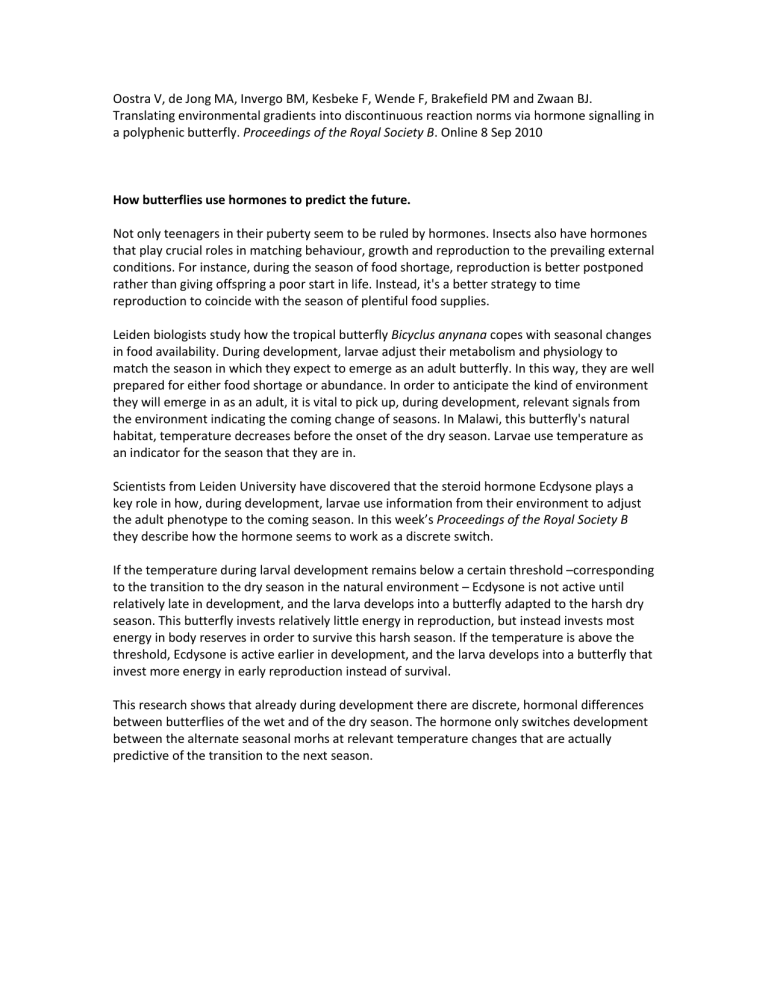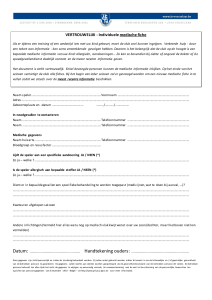
Oostra V, de Jong MA, Invergo BM, Kesbeke F, Wende F, Brakefield PM and Zwaan BJ.
Translating environmental gradients into discontinuous reaction norms via hormone signalling in
a polyphenic butterfly. Proceedings of the Royal Society B. Online 8 Sep 2010
How butterflies use hormones to predict the future.
Not only teenagers in their puberty seem to be ruled by hormones. Insects also have hormones
that play crucial roles in matching behaviour, growth and reproduction to the prevailing external
conditions. For instance, during the season of food shortage, reproduction is better postponed
rather than giving offspring a poor start in life. Instead, it's a better strategy to time
reproduction to coincide with the season of plentiful food supplies.
Leiden biologists study how the tropical butterfly Bicyclus anynana copes with seasonal changes
in food availability. During development, larvae adjust their metabolism and physiology to
match the season in which they expect to emerge as an adult butterfly. In this way, they are well
prepared for either food shortage or abundance. In order to anticipate the kind of environment
they will emerge in as an adult, it is vital to pick up, during development, relevant signals from
the environment indicating the coming change of seasons. In Malawi, this butterfly's natural
habitat, temperature decreases before the onset of the dry season. Larvae use temperature as
an indicator for the season that they are in.
Scientists from Leiden University have discovered that the steroid hormone Ecdysone plays a
key role in how, during development, larvae use information from their environment to adjust
the adult phenotype to the coming season. In this week’s Proceedings of the Royal Society B
they describe how the hormone seems to work as a discrete switch.
If the temperature during larval development remains below a certain threshold –corresponding
to the transition to the dry season in the natural environment – Ecdysone is not active until
relatively late in development, and the larva develops into a butterfly adapted to the harsh dry
season. This butterfly invests relatively little energy in reproduction, but instead invests most
energy in body reserves in order to survive this harsh season. If the temperature is above the
threshold, Ecdysone is active earlier in development, and the larva develops into a butterfly that
invest more energy in early reproduction instead of survival.
This research shows that already during development there are discrete, hormonal differences
between butterflies of the wet and of the dry season. The hormone only switches development
between the alternate seasonal morhs at relevant temperature changes that are actually
predictive of the transition to the next season.
Hoe vlinders met hun hormonen de toekomst voorspellen.
Niet alleen bij tieners in de pubertijd lijken hormonen de baas. Ook bij insecten spelen
hormonen een cruciale rol in het afstemmen van gedrag, groei en voortplanting op externe
omstandigheden. Zo heeft voortplanten weinig zin in een seizoen van voedselschaarste, omdat
dan nakomelingen een slechte start zullen maken. Een betere strategie is om de voortplanting
te laten samenvallen met het seizoen wanneer er ruimschoots voedsel beschikbaar is.
Leidse biologen onderzoeken hoe de tropische vlinder Bicyclus anynana zich aanpast aan de
afwisseling van seizoenen van voedselgebrek en –overvloed. Rupsen sturen, tijdens hun
ontwikkeling, hun metabolisme en fysiologie bij, afhankelijk van het seizoen waarin ze als vlinder
verwachten uit te komen. Op die manier zijn ze optimaal voorbereid op schaarste, of juist of
overvloed aan voedsel. Om te kunnen anticiperen op het soort omgeving waar ze als volwassen
vlinder in terecht zullen komen, is het cruciaal om al tijdens de ontwikkeling relevante signalen
uit de omgeving op te pikken die indicatief zijn voor de komende wisseling van de seizoenen. In
Malawi, waar deze vlinder van nature voorkomt, daalt de temperatuur voordat het droge
seizoen begint. Het was al bekend dat rupsen temperatuur gebruiken als indicator voor het
seizoen waarin ze zitten, en dat het steroïd hormoon Ecdyson hierbij betrokken is.
Nieuw is de ontdekking dat Ecdyson een beslissende rol speelt in hoe rupsen tijdens hun
ontwikkeling informatie uit de omgeving gebruiken om het volwassen fenotype aan te passen
aan het toekomstige seizoen. Wetenschappers van de Universiteit Leiden beschrijven deze week
in Proceedings of the Royal Society B hoe dit hormoon lijkt te werken als een schakelaar met
maar twee standen.
Als de temperatuur tijdens de ontwikkeling van de rupsen onder een bepaalde drempelwaarde
blijft — die in de natuur correspondeert met de transitie naar het droge seizoen — wordt dit
hormoon pas laat in de ontwikkeling actief en ontwikkelen de rupsen zich tot vlinders die
aangepast zijn aan de slechte, voedselarme omstandigheden van dit seizoen. Ze investeren
weinig energie in voortplanting, en veel in reserves om het droge seizoen door te komen. Als de
temperatuur boven die drempelwaarde komt, wordt Ecdyson eerder tijdens de ontwikkeling al
actief, en ontwikkelen de rupsen zich tot vlinders die aangepast zijn aan de voedselrijkdom van
het regenseizoen en veel energie investeren in snelle voorplanting.
Er zijn dus al tijdens de ontwikkeling discrete, hormonale verschillen tussen vlinders van het
droge en natte seizoen. Dit hormoon schakelt alleen tussen de twee fenotypes bij relevante
temperatuurveranderingen, die daadwerkelijk voorspellend zijn voor de wisseling van de
seizoenen.

![Beste [naam contactpersoon sponsor], Een nieuw seizoen](http://s1.studylibnl.com/store/data/000741072_1-1ef6c708f0e1fbfaf30bdfdac17b364d-300x300.png)








